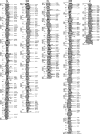A physical map for an Asian malaria mosquito, Anopheles stephensi
- PMID: 21036831
- PMCID: PMC2963963
- DOI: 10.4269/ajtmh.2010.10-0366
A physical map for an Asian malaria mosquito, Anopheles stephensi
Abstract
Physical mapping is a useful approach for studying genome organization and evolution as well as for genome sequence assembly. The availability of polytene chromosomes in malaria mosquitoes provides a unique opportunity to develop high-resolution physical maps. We report a 0.6-Mb-resolution physical map consisting of 422 DNA markers hybridized to 379 chromosomal sites of the Anopheles stephensi polytene chromosomes. This makes An. stephensi second only to Anopheles gambiae in density of a physical map among malaria mosquitoes. Three hundred sixty-three (363) probes hybridized to single chromosomal sites, whereas 59 clones yielded multiple signals. This physical map provided a suitable basis for comparative genomics, which was used for determining inversion breakpoints, duplications, and origin of novel genes across species.
Figures


Similar articles
-
A new chromosomal phylogeny supports the repeated origin of vectorial capacity in malaria mosquitoes of the Anopheles gambiae complex.PLoS Pathog. 2012;8(10):e1002960. doi: 10.1371/journal.ppat.1002960. Epub 2012 Oct 4. PLoS Pathog. 2012. PMID: 23055932 Free PMC article.
-
An integrated chromosome map of microsatellite markers and inversion breakpoints for an Asian malaria mosquito, Anopheles stephensi.J Hered. 2011 Nov-Dec;102(6):719-26. doi: 10.1093/jhered/esr072. Epub 2011 Aug 1. J Hered. 2011. PMID: 21810771 Free PMC article.
-
Improving the population genetics toolbox for the study of the African malaria vector Anopheles nili: microsatellite mapping to chromosomes.Parasit Vectors. 2011 Oct 19;4:202. doi: 10.1186/1756-3305-4-202. Parasit Vectors. 2011. PMID: 22011455 Free PMC article.
-
Genetic markers for study of the anopheline vectors of human malaria.Int J Parasitol. 2002 Dec 4;32(13):1607-15. doi: 10.1016/s0020-7519(02)00189-3. Int J Parasitol. 2002. PMID: 12435445 Review.
-
Chromosome phylogenies of malaria mosquitoes.Tsitologiia. 2013;55(4):238-40. Tsitologiia. 2013. PMID: 23875455 Review.
Cited by
-
Mitotic-chromosome-based physical mapping of the Culex quinquefasciatus genome.PLoS One. 2015 Mar 13;10(3):e0115737. doi: 10.1371/journal.pone.0115737. eCollection 2015. PLoS One. 2015. PMID: 25768920 Free PMC article.
-
A standard photomap of ovarian nurse cell chromosomes in the European malaria vector Anopheles atroparvus.Med Vet Entomol. 2015 Sep;29(3):230-7. doi: 10.1111/mve.12113. Epub 2015 Mar 17. Med Vet Entomol. 2015. PMID: 25776224 Free PMC article.
-
A Near-Chromosome Level Genome Assembly of Anopheles stephensi.Front Genet. 2020 Nov 16;11:565626. doi: 10.3389/fgene.2020.565626. eCollection 2020. Front Genet. 2020. PMID: 33312190 Free PMC article.
-
Transcriptome analysis of Anopheles stephensi embryo using expressed sequence tags.J Biosci. 2013 Jun;38(2):301-9. doi: 10.1007/s12038-013-9320-0. J Biosci. 2013. PMID: 23660664
-
Evolutionary superscaffolding and chromosome anchoring to improve Anopheles genome assemblies.BMC Biol. 2020 Jan 2;18(1):1. doi: 10.1186/s12915-019-0728-3. BMC Biol. 2020. PMID: 31898513 Free PMC article.
References
-
- Zhimulev IF. Morphology and Structure of Polytene Chromosomes. San Diego, CA: Academic Press; 1996. pp. 1–490. - PubMed
Publication types
MeSH terms
Substances
Grants and funding
LinkOut - more resources
Full Text Sources
Medical
Miscellaneous

